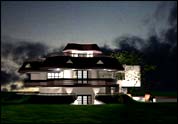|
Fundamentals of Advanced 3D Computer Graphics
The history of 3d computer graphics and its evolution over time application of
3d graphics in visualization, games, films and forensic science.
Introduction to 3D in Video Gaming
The role of computers in developing 3d games and its differences from other
forms of 3d learning modeling and texturing methods in low polygon for games
using gaming technology in real time visualization.
Concept Design and Planning
Every project begins with an idea. First step in bringing these ideas to life
is 'concept art'. A student is trained in preparing storyboards to make the
production process time efficient and context specific. In strict professional
deadlines, a well layed storyboard proves to be an invaluable tool.

The Art of Advanced Modeling in 3D
Modeling complex 3d meshes using spline, polygon, nurbs, patch techniques
modeling for animation - animation specific modeling methods optimizing 3d
models handling scenes with high polygon counts Low polygon modeling techniques
for gaming and visualization.
Advanced Lighting and Materials
 Good
lighting and materials is the first and foremost requirement for a good
rendering. It dictates the extent of realism in a scene. A sound knowledge of
real life lighting principles and materials only can make a CG scene realistic
in true sense. Keeping this in mind the course teaches principles of real world
lighting viz color, intensity, exposure, softness, throw, attenuation Types of
lights in CG Simulating sunlight or daylight, nightlight, lighting for
interiors and task lighting Casting accurate and detailed shadows in 3d scenes
Forcing distance and perspective with lights Advanced lighting techniques like
ray tracing, global illumination and radiosity to create true to life
renderings Understanding Materials and Shaders Advanced Materials - Simulating
real world materials Handling advanced parameters of reflection, transparency,
refraction effectively Creating textures from the scratch Introduction to
industry tested advanced rendering systems - Brazil and Mental Ray. Good
lighting and materials is the first and foremost requirement for a good
rendering. It dictates the extent of realism in a scene. A sound knowledge of
real life lighting principles and materials only can make a CG scene realistic
in true sense. Keeping this in mind the course teaches principles of real world
lighting viz color, intensity, exposure, softness, throw, attenuation Types of
lights in CG Simulating sunlight or daylight, nightlight, lighting for
interiors and task lighting Casting accurate and detailed shadows in 3d scenes
Forcing distance and perspective with lights Advanced lighting techniques like
ray tracing, global illumination and radiosity to create true to life
renderings Understanding Materials and Shaders Advanced Materials - Simulating
real world materials Handling advanced parameters of reflection, transparency,
refraction effectively Creating textures from the scratch Introduction to
industry tested advanced rendering systems - Brazil and Mental Ray.
Cameras
The course facilitates learning the Fundamentals of Composition & Spatial
arrangement, balance, direction, and rhythm Animating Cameras for realistic and
dramatic motion.
Animation
Concepts of animation Animation Controllers Parametric or Transform Animation
Using the curve editor to control animation Animating materials, cameras and
lights Inverse Kinematics - Animating two and four legged characters using
bones adding animated human figures in 3d environments Facial Animation and Lip
Syncing Planning and time management for Animation.
Special FX and Post Production

Simulating realistic fire, smoke, wind, water, explosions.Using Particle
Systems to Model trees, flock of flying birds, water fountains Space warps to
create effects like ripples in water, blowing wind, waves etc: Simulating
Atmospheric effects like Fog, Volume Light, Volume Fog Render Effects to add
glow, lens flare, depth of field Using Video Post for effects and compilation
composting for FX.
Finishing
Choosing the right output media for your product - saving to CD's, DVD's;
saving for the web; choosing an appropriate output format; audio and video
compressors and decoders; NTSC & PAL systems - associated frame rates and
resolutions.
|




